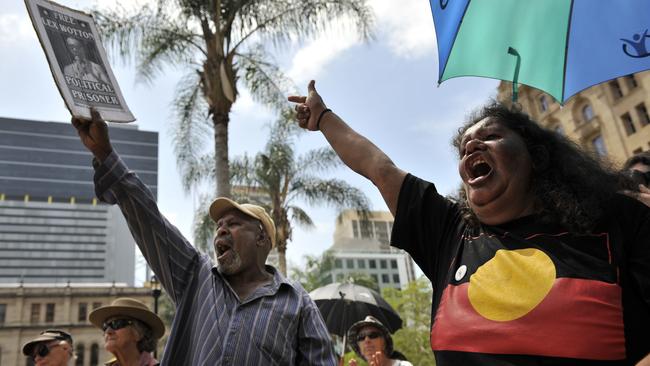This routine lack of justice should shame Australia

In 2015, I was briefed on the Palm Island class action brought by Lex Wotton and members of the Palm Island community in what would become a landmark decision against the Queensland Police Service and the state of Queensland for racial discrimination. The court found the Racial Discrimination Act 1975 had been breached by police in relation to the investigation of the death of Mulrunji Doomadgee and the response of the Queensland police that followed a protest by Palm Islanders.
Mulrunji died in police custody about 11am on November 19, 2004. About 10.20am a witness saw Mulrunji punch Senior Sergeant Chris Hurley as he was being removed from the back of a police van. The two men than engaged in a “struggle”. Minutes later Mulrunji was dragged limp into the watch-house cell. For the 40 minutes Mulrunji lay on the cell floor he didn’t move. I know because I have watched the video. The police later said they assumed Mulrunji was “asleep”; an assumption that seems illogical when a person could punch a police officer, engage in a struggle and then fall to sleep, all in the space of three or four minutes.
Mulrunji sustained a ruptured liver and portal vein (commonly associated with car accident injuries), four broken ribs and an injury above his eye. Justice Debbie Mortimer said “it is clear he did not enter custody less than an hour earlier with those injuries”.
Police officers Raymond Kitching, Darren Robinson and Warren Webber were sent from Townsville to investigate the death. Robinson was the detective stationed on Palm Island and a known associate of Hurley. Justice Mortimer found the investigation into Mulrunji’s death was not impartial, independent or effective. Her criticisms included “Hurley was never treated as a suspect, the police officers discounted and ignored accounts from Aboriginal witnesses implicating Hurley and gave incorrect and stereotypical information about Mulrunji and the circumstances of his death to the coroner, while relevant information from Aboriginal witnesses was not passed on”. That “incorrect and stereotypical” information was a guise that Mulrunji had been sniffing and drinking bleach and was involved in a car accident in the days prior.
What the events surrounding Mulrunji’s death demonstrate most is that when it comes to Aboriginal and Torres Strait Islander people in custody, they are often treated with callous disregard. It is the same callous disregard and illogical behaviour that I witnessed when I watched police body camera footage of the 2018 death in Townsville of Aboriginal man Trevor King. King died metres from his home following a struggle with police. As King’s partner and children watched on, screaming for the officer to “get off him”, “he’s got a bad heart”, “he can’t breathe”, the officer failed to heed their concerns. The most striking scenes are when King’s partner says “something is wrong with him”, as his eyes roll back in his head and he starts to foam at the mouth. Rather than take any action, the police and ambulance officers (who stopped after they happened to be driving past on their way to another call) respond “he’s OK, he’s just sleeping”.
In watching the videos of Mulrunji, King and others, the common element is the complete disregard shown for their lives — a sense of them being less worthy of humane treatment because they are Aboriginal. If a police officer was stumbling over, continually hitting his head, do we really believe the other officers would sit back and not assist? But that is exactly what happened in these cases. There is an underlying irrationality applied to their suffering. It is the same disregard for life that the world has witnessed in the death of George Floyd, Eric Garner and other deaths at the hands of police in the US.
We simply cannot allow this to continue and expect there to be any real change. Aboriginal and Torres Strait Islander families are continually let down by the investigation process. The ultimate prosecution of Hurley in Mulrunji’s death relied primarily on the evidence collected during the investigation of Webber and Kitching, an investigation that lacked impartiality, independence or effectiveness. How in those circumstances could anyone expect a successful prosecution, let alone getting to the truth of the matter?
It is the same scenario that plays out in investigations into black deaths in custody across the country. Aboriginal and Torres Strait Islander families will be told by police “we are preparing a report for the coroner”, which really means we are conducting a second-rate investigation. And if you believe that “preparing a report for the coroner” is not a mediocre investigation, ask yourself: do you believe if Hurley had of died in the minutes following the “struggle” with Mulrunji, or the police officer who tackled King had died moments later, the police simply would have prepared a report for the coroner? The response to that question reveals the difference in treatment of black deaths in custody. The only solution is for an independent investigative body, not made up of former police officers (who bring their own cultural influences) to conduct each and every investigation.
The body could sit at the federal level with state-based teams and be deployed immediately on notification of a death. It is this type of significant change that is needed if we are ever to achieve the shift in the treatment of Aboriginal and Torres Strait Islander people in custody and the conduct of investigations into their deaths.
Joshua Creamer is a barrister in Brisbane.


In the 29 years since the Royal Commission into Aboriginal Deaths in Custody published its final report in April 1991 there have been 432 Aboriginal and Torres Strait Islander deaths in custody.